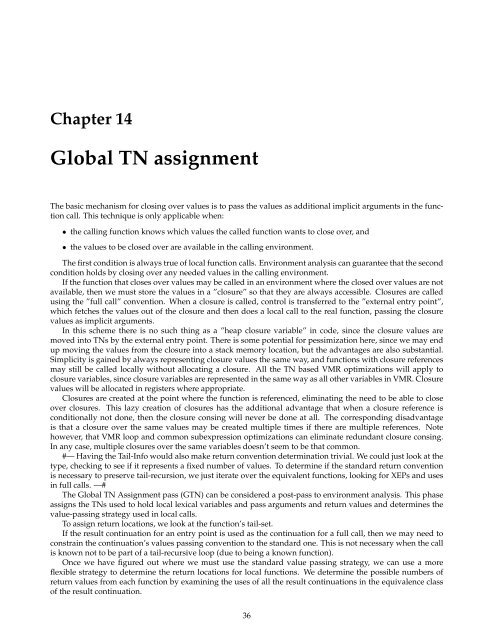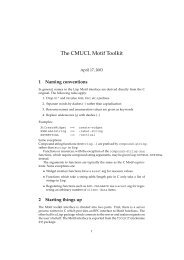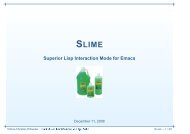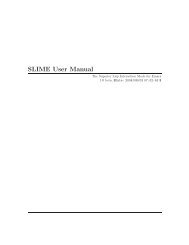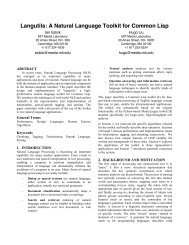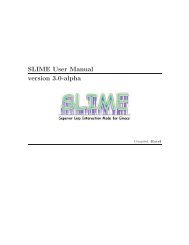Design of CMU Common Lisp.pdf - Common Lisp.net
Design of CMU Common Lisp.pdf - Common Lisp.net
Design of CMU Common Lisp.pdf - Common Lisp.net
Create successful ePaper yourself
Turn your PDF publications into a flip-book with our unique Google optimized e-Paper software.
Chapter 14<br />
Global TN assignment<br />
The basic mechanism for closing over values is to pass the values as additional implicit arguments in the function<br />
call. This technique is only applicable when:<br />
• the calling function knows which values the called function wants to close over, and<br />
• the values to be closed over are available in the calling environment.<br />
The first condition is always true <strong>of</strong> local function calls. Environment analysis can guarantee that the second<br />
condition holds by closing over any needed values in the calling environment.<br />
If the function that closes over values may be called in an environment where the closed over values are not<br />
available, then we must store the values in a ”closure” so that they are always accessible. Closures are called<br />
using the ”full call” convention. When a closure is called, control is transferred to the ”external entry point”,<br />
which fetches the values out <strong>of</strong> the closure and then does a local call to the real function, passing the closure<br />
values as implicit arguments.<br />
In this scheme there is no such thing as a ”heap closure variable” in code, since the closure values are<br />
moved into TNs by the external entry point. There is some potential for pessimization here, since we may end<br />
up moving the values from the closure into a stack memory location, but the advantages are also substantial.<br />
Simplicity is gained by always representing closure values the same way, and functions with closure references<br />
may still be called locally without allocating a closure. All the TN based VMR optimizations will apply to<br />
closure variables, since closure variables are represented in the same way as all other variables in VMR. Closure<br />
values will be allocated in registers where appropriate.<br />
Closures are created at the point where the function is referenced, eliminating the need to be able to close<br />
over closures. This lazy creation <strong>of</strong> closures has the additional advantage that when a closure reference is<br />
conditionally not done, then the closure consing will never be done at all. The corresponding disadvantage<br />
is that a closure over the same values may be created multiple times if there are multiple references. Note<br />
however, that VMR loop and common subexpression optimizations can eliminate redundant closure consing.<br />
In any case, multiple closures over the same variables doesn’t seem to be that common.<br />
#— Having the Tail-Info would also make return convention determination trivial. We could just look at the<br />
type, checking to see if it represents a fixed number <strong>of</strong> values. To determine if the standard return convention<br />
is necessary to preserve tail-recursion, we just iterate over the equivalent functions, looking for XEPs and uses<br />
in full calls. —#<br />
The Global TN Assignment pass (GTN) can be considered a post-pass to environment analysis. This phase<br />
assigns the TNs used to hold local lexical variables and pass arguments and return values and determines the<br />
value-passing strategy used in local calls.<br />
To assign return locations, we look at the function’s tail-set.<br />
If the result continuation for an entry point is used as the continuation for a full call, then we may need to<br />
constrain the continuation’s values passing convention to the standard one. This is not necessary when the call<br />
is known not to be part <strong>of</strong> a tail-recursive loop (due to being a known function).<br />
Once we have figured out where we must use the standard value passing strategy, we can use a more<br />
flexible strategy to determine the return locations for local functions. We determine the possible numbers <strong>of</strong><br />
return values from each function by examining the uses <strong>of</strong> all the result continuations in the equivalence class<br />
<strong>of</strong> the result continuation.<br />
36


